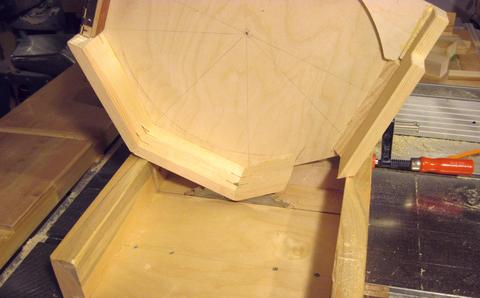 The top of the saw has 45-degree corners. I joined these with
simple 22.5 degree mitered butt joints. After the glue dried, I cut some
slots into the corners for splines on the table saw. A table saw sled is handy
for this operation.
The top of the saw has 45-degree corners. I joined these with
simple 22.5 degree mitered butt joints. After the glue dried, I cut some
slots into the corners for splines on the table saw. A table saw sled is handy
for this operation.
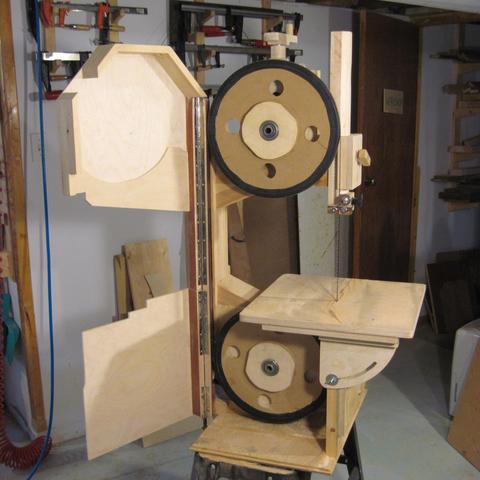 Building the enclosure for the bandsaw is kind of anticlimactic compared
to other parts of the construction. With the saw being a known quantity by this point,
there just isn't the same kind of anticipation anymore.
Building the enclosure for the bandsaw is kind of anticlimactic compared
to other parts of the construction. With the saw being a known quantity by this point,
there just isn't the same kind of anticipation anymore.
But given the safety aspects, the enclosure may in fact be the most important part of the bandsaw!
 The top of the saw has 45-degree corners. I joined these with
simple 22.5 degree mitered butt joints. After the glue dried, I cut some
slots into the corners for splines on the table saw. A table saw sled is handy
for this operation.
The top of the saw has 45-degree corners. I joined these with
simple 22.5 degree mitered butt joints. After the glue dried, I cut some
slots into the corners for splines on the table saw. A table saw sled is handy
for this operation.
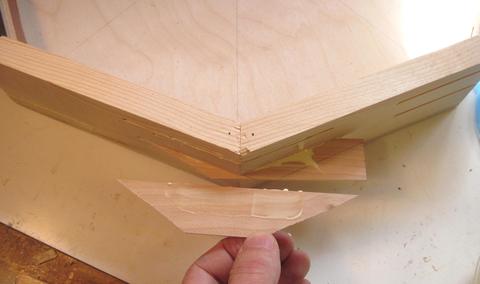 I cut some strips of hardwood to use as splines and glued those into
the slots. After the glue dried, I cut them flush on the bandsaw,
then chiselled and sanded them flush.
I cut some strips of hardwood to use as splines and glued those into
the slots. After the glue dried, I cut them flush on the bandsaw,
then chiselled and sanded them flush.
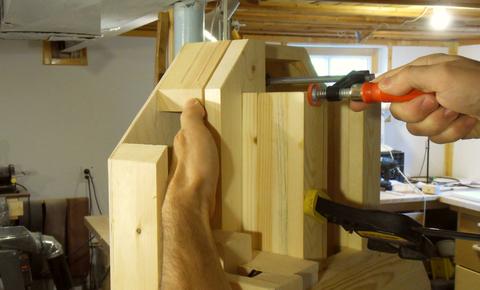 The covers on this bandsaw close with hinges along the left. A piece of wood
is attached to the right of the two wheel mount posts to mount a latch.
The easiest way to align that is to take the
top wheel out of the saw, close the cover, and position the piece so
it lines up with the edges of the cover.
The covers on this bandsaw close with hinges along the left. A piece of wood
is attached to the right of the two wheel mount posts to mount a latch.
The easiest way to align that is to take the
top wheel out of the saw, close the cover, and position the piece so
it lines up with the edges of the cover.
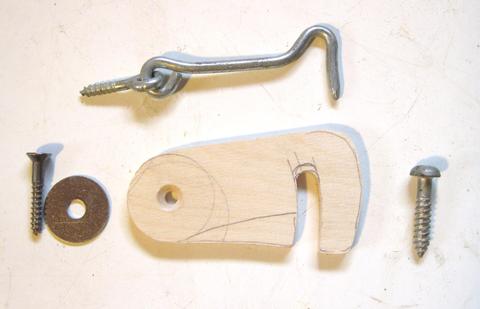 I like to use hooks like the one at the top of this picture. These
can be bought at hardware stores. But if you don't know where to find one of those,
you could try bending one out of metal yourself, or make something similar
out of plywood.
I like to use hooks like the one at the top of this picture. These
can be bought at hardware stores. But if you don't know where to find one of those,
you could try bending one out of metal yourself, or make something similar
out of plywood.
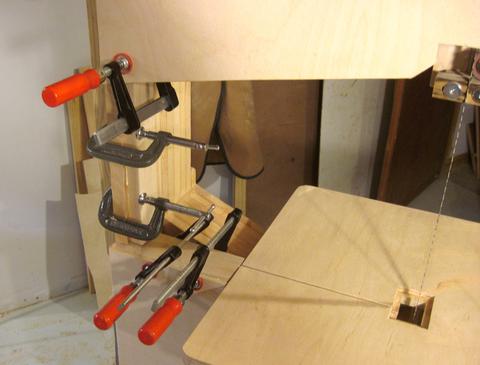 Gluing on an L-shaped profile to cover up the blade. This part is hinged
with the top cover, so that when the top cover is opened, the left blade guard
also opens.
Gluing on an L-shaped profile to cover up the blade. This part is hinged
with the top cover, so that when the top cover is opened, the left blade guard
also opens.
The hinged cover for this saw is more convenient than the cover that slides on from the top on my previous design, although it was slightly more work to construct.
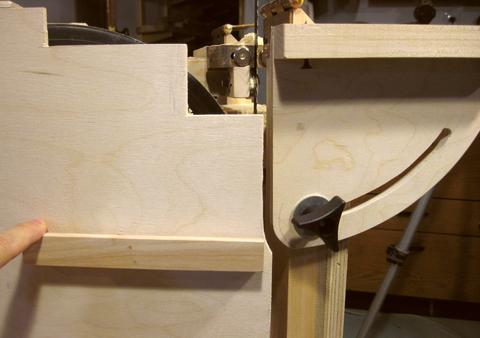 The bottom cover also swings open on a hinge at the left.
Unfortunately, the bottom cover would end up hitting the table tilt lock as it
swung open, so I had to cut away part of the cover to clear that.
The bottom cover also swings open on a hinge at the left.
Unfortunately, the bottom cover would end up hitting the table tilt lock as it
swung open, so I had to cut away part of the cover to clear that.
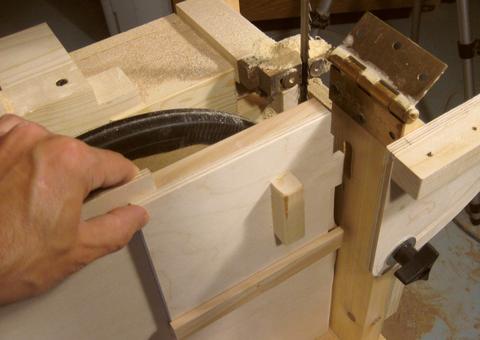 My solution was to make a really big sliding latch for the bottom cover. The piece
is about 15x15 cm. It hooks over the top of the cover and also slides in a
track on the bottom. The section protruding out of this latch fits into
a slot cut into the table supports. When the latch is closed, the cutout
in the bottom cover is completely covered.
My solution was to make a really big sliding latch for the bottom cover. The piece
is about 15x15 cm. It hooks over the top of the cover and also slides in a
track on the bottom. The section protruding out of this latch fits into
a slot cut into the table supports. When the latch is closed, the cutout
in the bottom cover is completely covered.
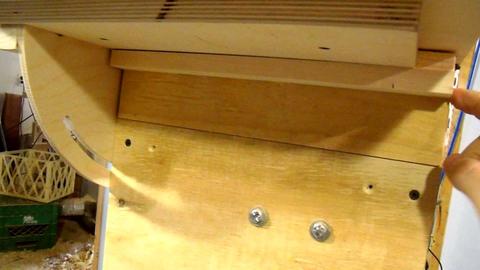 I also made a piece that slides in between the table and the table support
to cover the blade guides. This piece only fits in place with the table
set at 90 degrees, so it needs to be removed when tilting the table.
I also made a piece that slides in between the table and the table support
to cover the blade guides. This piece only fits in place with the table
set at 90 degrees, so it needs to be removed when tilting the table.
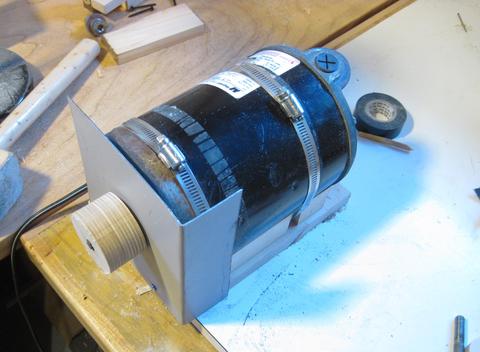 I also added a piece of sheet metal to the motor mount.
I also added a piece of sheet metal to the motor mount.
The pump motor that I'm using pulls cooling air in the front and blows it out the back. I didn't want it pulling in the dusty air from the bottom enclosure, so I made this piece of sheet metal (cut from an old PC case). There's enough room behind it to allow the motor to pull in air from the sides.
I had to take the pulley off to put this cover on, but I'd found that the old pulley slipped from time to time, so I made a new one that fit tighter. I took this photo with the pulley blank on, before I turned it to a pulley shape.
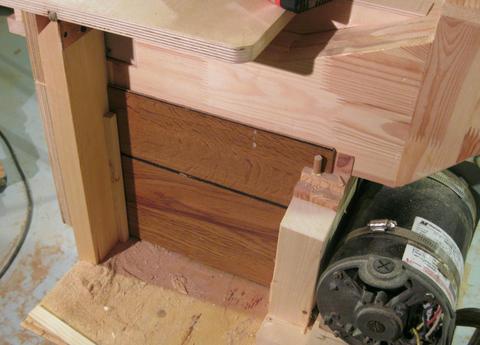 And another piece of wood to cover the bottom back of the saw.
And another piece of wood to cover the bottom back of the saw.
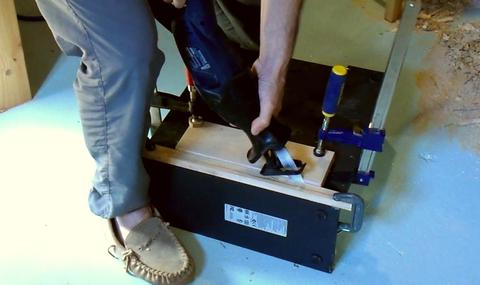 I needed to make a piece of C-channel for the blade guard that attaches
to the guide post. Previously,
I had cut this out from a PC case with an angle grinder, but I have since
bought a reciprocating saw. Cutting up PC cases
is the best use I have found for this saw yet!
I needed to make a piece of C-channel for the blade guard that attaches
to the guide post. Previously,
I had cut this out from a PC case with an angle grinder, but I have since
bought a reciprocating saw. Cutting up PC cases
is the best use I have found for this saw yet!
Unfortunately, the blade of this saw likes to wander a bit, so I clamped some bits of hardwood to either side of the cut I was making. I used bar clamps and C-clamps, though if doing it again, I'd only use C-clamps. The vibrations had a tendency to loosen up the bar clamps.
That PC case is the same one that I cut the blade guide of my last saw out of, and also one I used as a back stop for shooting my air gun. So I guess that case is now fully used up!
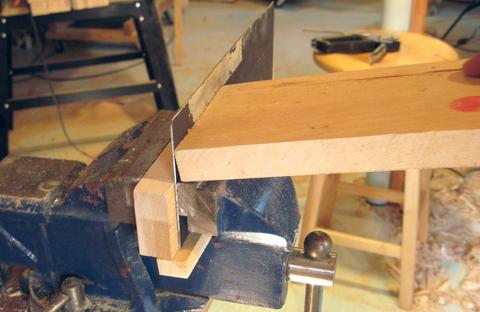 The piece I cut out included an edge of the case, so I already had one
90-degree bend to start with. The challenge was to produce another 90-degree bend.
The piece I cut out included an edge of the case, so I already had one
90-degree bend to start with. The challenge was to produce another 90-degree bend.
A sheet metal brake would make short work of a job like this, but I'm not really set up for metal work.
So I cut a piece of hardwood to be the same width as the channel I wanted and clamped the sheet metal and piece of wood in the vise.
I then used another piece of hardwood to bend a corner into this channel. I put the end of the piece of wood against the edge I wanted to bend and struck the other end with a hammer. With the metal much longer than my vise is wide, I only bent it by about 10-degrees, I then repositioned it to extend the bend along the length of the metal.
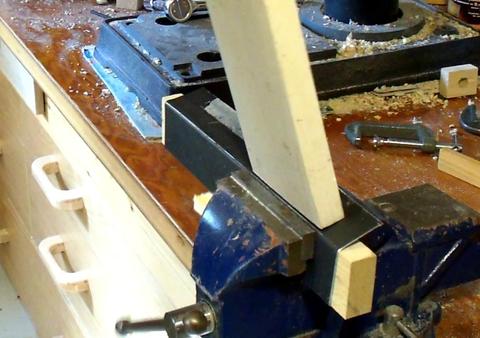 Working my way back and forth several times, I was able to get a clean 90-degree
bend without kinking or distorting the metal.
Working my way back and forth several times, I was able to get a clean 90-degree
bend without kinking or distorting the metal.
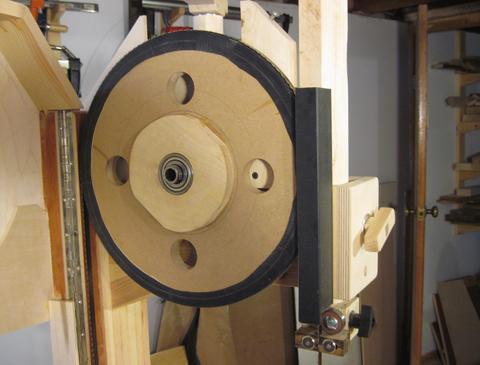 The C-channel needs to be able to fit around the upper wheel. On commercial
bandsaws, this tends not to be as critical, but with the large resaw depth this
saw is capable of, making the guard fit around the wheel is the only way to allow
it to move up far enough.
The C-channel needs to be able to fit around the upper wheel. On commercial
bandsaws, this tends not to be as critical, but with the large resaw depth this
saw is capable of, making the guard fit around the wheel is the only way to allow
it to move up far enough.
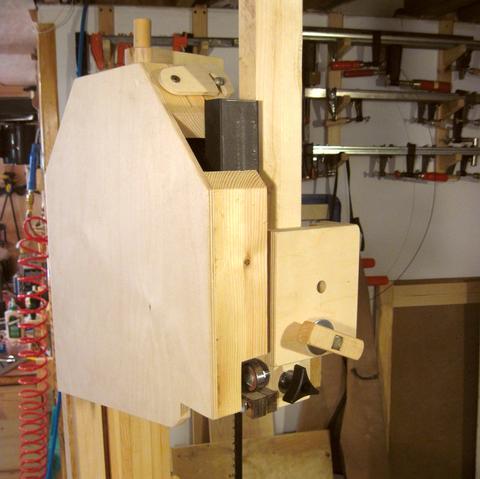 With a maximum resaw depth of 30 cm (almost 12"), when the blade guide
is positioned all the way up, the blade guard actually protrudes out of the
top of the enclosure. The guide post ends up being the highest part of the saw.
With a maximum resaw depth of 30 cm (almost 12"), when the blade guide
is positioned all the way up, the blade guard actually protrudes out of the
top of the enclosure. The guide post ends up being the highest part of the saw.
As with my previous design, the guide post clamp has two holes in it so that it can be positioned higher for the last 5 cm (2") of vertical range.
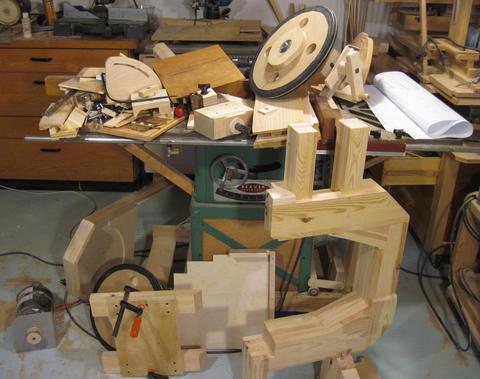 With all the woodwork done, it was time to take it all apart again for varnishing.
With all the woodwork done, it was time to take it all apart again for varnishing.
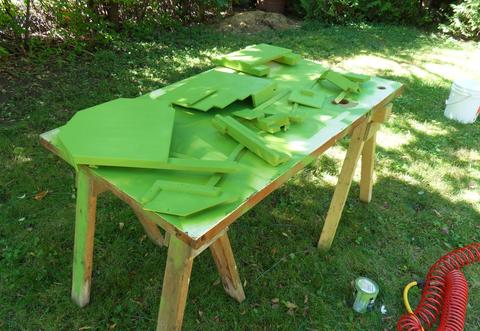 I have gotten to the habit of spray painting my machines.
I spray painted my other bandsaws too, and that worked out well. I'm using
regular indoor paint from The Home Depot - the relatively thick stuff
that is normally applied with a roller.
I have gotten to the habit of spray painting my machines.
I spray painted my other bandsaws too, and that worked out well. I'm using
regular indoor paint from The Home Depot - the relatively thick stuff
that is normally applied with a roller.
When I built the jointer, the weather outside wasn't suitable for spraying, so I brushed the paint on. I have to say, spraying produces a much more consistent finish.
After spraying on two coats of paint, I added two coats of waterborne Varathane diamond floor varnish to give it a nice gloss and protect the paint. This method has stood up well on my other machines.
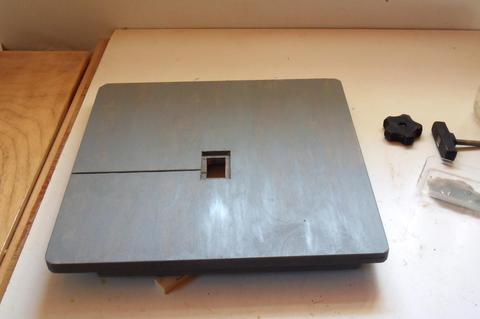 In my previous bandsaws, the table was a panel from a piece of furniture, so
I just left the original finish on it, but added a few more coats. This time,
I used Baltic Birch. I have learned that it helps a lot to have the machine
contrast form the workpiece, so I painted the table a drak-ish gray. I also painted
the hand made knobs black.
In my previous bandsaws, the table was a panel from a piece of furniture, so
I just left the original finish on it, but added a few more coats. This time,
I used Baltic Birch. I have learned that it helps a lot to have the machine
contrast form the workpiece, so I painted the table a drak-ish gray. I also painted
the hand made knobs black.
After painting the table, I added two coats of Varathane diamond floor varnish to give it a smooth hard surface that glides easily.
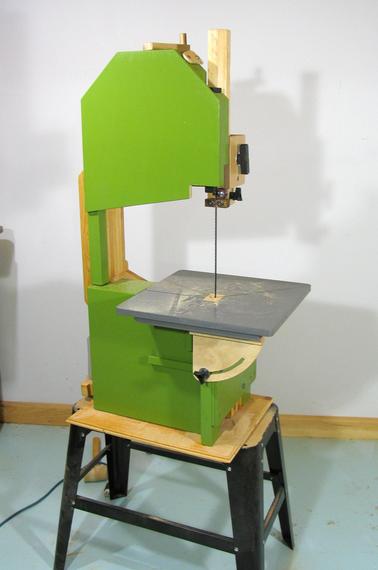 And here's the bandsaw put back together, placed on the sheet metal
stand that came with my cheap thickness planer.
And here's the bandsaw put back together, placed on the sheet metal
stand that came with my cheap thickness planer.
It weighs about 82 pounds (38 Kg). The resaw capacity is about 30 cm (nearly 12") with a 93.5" blade. The blade guide, in its uppermost position, is nearly flush with the edge of the enclosure.
Next week, I'll write more about what I learned in the process of building this saw, and show off what the saw is capable of.
Next: Bandsaw complete, and things learned